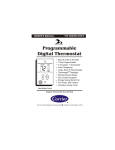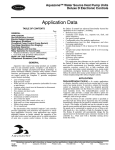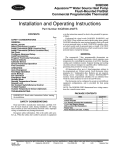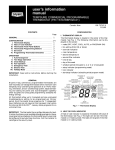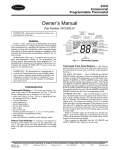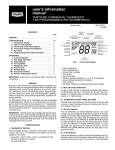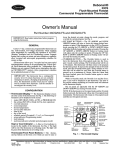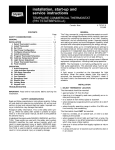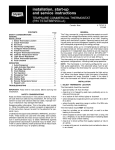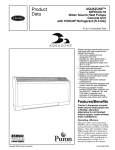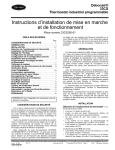Download Carrier 50QE900-511WS Owner`s manual
Transcript
50QE900 Aquazone™ Water Source Heat Pump Commercial 5-1-1 Day Programmable Thermostat Owner’s Manual Part Number 50QE900-511WS IMPORTANT: Read entire instructions before programming the thermostat. GENERAL The Aquazone commercial, programmable thermostats are wall-mounted, low-voltage thermostats which maintain room temperature by controlling the operation of an HVAC (heating, cooling and ventilation) system. Separate heating and cooling set points and auto-changeover capability allow occupied and unoccupied programming schedules for energy savings. All thermostats allow up to 3 occupied and one unoccupied time/temperature setting to be programmed per 24-hr period. Each thermostat stores programs for 3 daily schedules (Saturday, Sunday, and Monday through Friday). Batteries are not required. During power interruption the internal NEVERLOST™ memory stores programs for an unlimited time. set points. The UP ARROW and DOWN ARROW buttons are also used in Programming mode. OVERRIDE BUTTON — The Override button is used to force the thermostat from Unoccupied mode into the Occupied 1 mode comfort settings. The Override period will be set at 30 minutes. The thermostat will then return to Unoccupied mode. To increase the amount of time in Override mode, press the Override button again. Thirty minutes of override time will be added for each time the Override button is pressed up to a maximum of 4 hours. After the 4-hour limit has been reached, press the Override button again to cancel Override mode. While in Override mode, the Override icon and the Occupied 1 icon will be displayed on the thermostat. The time of day and the minutes remaining in Override mode will alternate on the thermostat display. CONFIGURATION Thermostat Display — The thermostat display is located in the center of the thermostat. See Fig. 1. The following information can be displayed on the screen: • mode (OFF, HEAT, COOL, AUTO, or PROGRAM ON) • fan setting (FAN ON or blank) • override indication • room temperature • desired temperature • time of day • day of the week • schedule period (Occupied 1, 2, or 3; or Unoccupied) • setup indicator (Programming mode) • lock indicator • start/stop indicator (schedule period Programming mode) Heat or Cool Indicator — A Heat or Cool indicator is located on the bottom middle cover of the thermostat. See Fig. 2. The light will be red if the thermostat is in Heating mode. The light will be green if the thermostat is in Cooling mode. Thermostat Front Panel Buttons — The thermostat has buttons on the front cover which are used to raise or lower the desired set point and override the current program. See Fig. 2. SET POINT BUTTONS — The UP ARROW and DOWN ARROW buttons will raise or lower the current desired temperature set point. If the thermostat is in AUTO mode, pressing the UP ARROW or DOWN ARROW button will adjust both the heating and cooling set points. Pressing the UP ARROW or DOWN ARROW button in Cooling mode will adjust only the cooling set points. Pressing the UP ARROW or DOWN ARROW button in Heating mode will adjust only the heating Fig. 1 — Thermostat Display Mo DISPLAY SCREEN MODE BUTTON Am COOL AUTO HEAT OVERRIDE BUTTON INDICATOR LIGHT DOWN ARROW BUTTON UP ARROW BUTTON Fig. 2 — Thermostat Front Cover Manufacturer reserves the right to discontinue, or change at any time, specifications or designs without notice and without incurring obligations. PC 111 Catalog No. 535-00109 Printed in U.S.A. Form 50QE-2SO Pg 1 6-03 Replaces: New Book 1 4 Tab 5a 5a The set points are adjustable with the UP ARROW and DOWN ARROW keys during Override mode. NOTE: If the thermostat is in Occupied mode and the Override button is pressed, the thermostat will go into Unoccupied mode immediately. The thermostat will remain in Unoccupied mode until the next Occupied start time. KEYPAD LOCK — The thermostat has a keypad lockout feature which will not acknowledge front panel buttons until the lockout sequence is entered. To disable or lock the keypad, press and hold the Mode button. While holding down the Mode button, press the UP and DOWN ARROW buttons simultaneously. The ‘‘Locked’’ icon will appear on the display. The thermostat is unlocked by performing the same procedure. Press and hold the Mode button. While holding down the Mode button, press the UP and DOWN ARROW buttons simultaneously. The ‘‘Locked’’ icon will be removed from the display. MODE BUTTON OPERATION — The Mode button selects the operating mode of the thermostat. If OFF is selected, the thermostat will not enter Heating or Cooling mode. If HEAT is selected, the thermostat will only enter Heating mode (if the room temperature is below the heating set point). If COOL is selected, the thermostat will only enter Cooling mode (if the room temperature is above the cooling set point). If AUTO is selected, the thermostat will enter Heating or Cooling mode based on the room temperature and the heating and cooling set points. If PROGRAM ON is selected, the stored schedule is enabled and the thermostat will follow the Occupied and Unoccupied schedules stored in its memory. Auto-Changeover — When the thermostat mode is set to AUTO, the thermostat will provide automatic changeover from Heating to Cooling mode and Cooling to Heating mode when required. The thermostat will automatically switch to maintain the desired temperature setting. The thermostat does not need to be manually changed from heating to cooling or cooling to heating operation. NOTE: It is recommended that auto-changeover mode not be used if the outdoor temperature is consistently lower than 50 F (10 C) or greater than 80 F (27 C). In these cases, select Heating or Cooling mode only. Fig. 3 — Setting the Clock set point and a cooling set point. The unoccupied time period is active whenever an occupied time period is not active. Fill in Table 1 on page 3 as an aid to programming the daily schedules. PROGRAMMING MODE — To program the daily schedules, perform the following procedure: 1. Enter Programming mode by pressing and holding the Mode and UP ARROW buttons. The Occupied 1 annunciator will appear on the thermostat display. See Fig. 4. Use the UP ARROW and DOWN ARROW buttons to set the maximum number of Occupied periods available. The thermostat can be set to 1, 2, or 3. After the number of Occupied periods has been selected, press the Mode button. 2. The cooling set point for Occupied 1 will be displayed. Use the UP ARROW and DOWN ARROW buttons to raise or lower the cooling set point until the desired temperature is shown. The range of acceptable values is 35 to 99 F (1 to 37 C). Press the Mode button to continue. See Fig. 4. 3. The heating set point for Occupied 1 will be displayed. Use the UP ARROW and DOWN ARROW buttons to raise or lower the heating set point until the desired temperature is shown. The range of acceptable values is 35 to 99 F (1 to 37 C). Press the Mode button to continue. See Fig. 4. 4. The cooling set point for Unoccupied will be displayed. Use the UP ARROW and DOWN ARROW buttons to raise or lower the cooling set point until the desired temperature is shown. The range of acceptable values is 35 to 99 F (1 to 37 C) or ‘‘OF’’ (no unoccupied cooling). To configure to ‘‘OF,’’ press UP ARROW when display is showing ‘‘99.’’ Press the Mode button to continue. 5. The heating set point for Unoccupied will be displayed. Use the UP ARROW and DOWN ARROW buttons to raise or lower the heating set point until the desired temperature is shown. The range of acceptable values is 35 to 99 F (1 to 37 C) or ‘‘OF’’ (no unoccupied heating). To configure to ‘‘OF,’’ press DOWN ARROW when display is showing ‘‘35.’’ Press the Mode button to continue. 6. The day of the week will be shown. Use the UP ARROW and DOWN ARROW buttons to change the day of the week until the desired starting day is shown. Possible choices are Mo-Fr (Monday through Friday), Sa (Saturday), and Su (Sunday). Press the Mode button when the desired day is shown. 7. The Start Time for Occupied 1 for the chosen day will be displayed. Use the UP ARROW and DOWN ARROW buttons to raise or lower the time until the desired Start Time is shown. Press the Mode button to continue. See Fig. 5. Set Clock — The Set Clock function allows the user to change the time and day displayed on the thermostat. Press and hold the Mode and Override buttons for 2 seconds to enter Set Clock mode. See Fig. 3. The current time will blink on and off. Press the UP ARROW or DOWN ARROW button until the correct time is shown. Hold down the buttons to quickly move through the time display. The AM and PM annunciators will automatically change. To scroll through by hours only, press and hold the Override button while pressing the UP or DOWN ARROW button. To ensure the schedules are properly followed, make sure that AM or PM is correct for the time chosen. When the correct time is shown, press the Mode button to modify the day of the week. The current day will blink on and off. Press the UP ARROW or DOWN ARROW button until the correct day is shown. Press and hold the Mode and Override buttons for 2 seconds again to exit the Set Clock mode. Programming Thermostat Schedules — Before programming the thermostat, plan the thermostat daily schedule. The schedule is divided into 3 daily schedules (Saturday, Sunday, and Monday through Friday). The daily schedule for Monday through Friday is the same. Each day can have 2 (Occupied 1, Unoccupied), 3 (Occupied 1, Occupied 2, Unoccupied), or 4 (Occupied 1, Occupied 2, Occupied 3, Unoccupied) time periods. Each occupied time period has a start time, stop time, heating set point, and cooling set point. The Occupied 1 and Unoccupied temperature set points are the same for each day. The unoccupied time period has a heating 2 for 24 hours and occupied schedule 2 comes on from 1 to 3 PM, the set points from Occupied 2 are in effect from 1 to 3 PM. OVERRIDING THE SCHEDULE — The schedule can be overridden during operation by pressing the UP or DOWN ARROW buttons to change the desired temperature. The thermostat will use the new set point until the next scheduled time period starts. 8. The Stop Time for Occupied 1 for the chosen day will be displayed. Use the UP ARROW and DOWN ARROW buttons to raise or lower the time until the desired Stop Time is shown. Press the Mode button. 9. The On/Off icon will be displayed. Use the UP ARROW to turn the Occupied 1 period ON for this day. Use the DOWN ARROW to turn the Occupied 1 period OFF for this day. 10. If the Occupied 2 and/or Occupied 3 time periods were selected in Step 1, they will need to be configured. Set the cooling set point, heating set point, start time, stop time, and on/off configuration for Occupied 2 and 3 time periods for that day (Sa, Su, Mo-Fr). If the Occupied 2 and 3 time periods were not selected in Step 1, skip to Step 11. Press the Mode button to continue. 11. The program schedule will move forward to the next day (Sa, Su, Mo-Fr). Repeat Steps 7 to 10 for that day schedule. 12. The program will continue to cycle through the 3 schedules (Sa, Su, Mo-Fr) and repeating Steps 7 to 10. Press the Mode and UP ARROW buttons at the same time to exit Programming mode. NOTE: The thermostat will continue to follow the schedule until a new one is entered. • If only one occupied schedule is selected, the Occupied 2 and 3 schedules are skipped. • If the start time is set later in the day than the stop time, the program will run from midnight of that day to the stop time and then from the start time to midnight. • If the same start and stop times are programmed for an occupancy schedule, the thermostat will be in Occupied mode for 24 hours. • If one occupied period starts or stops within another occupied period, the lower numbered schedule has priority. For example, if schedule Occupied 3 is running Fig. 4 — Setting Occupied 1 Set Points Fig. 5 — Start Time Display Table 1 — Daily Schedule Planner DAY OF THE WEEK Occupied 1 Start / Stop / Heat / Cool* SCHEDULE Occupied 2 Start / Stop / Heat / Cool Occupied 3 Start / Stop / Heat / Cool Unoccupied Heat / Cool* MondayFriday / / / / / / / / / / Saturday / / / / / / / / / / Sunday / / / / / / / / / / *The heat and cool temperature set points for Occupied 1 and Unoccupied are the same for each day. NOTE: The cooling temperature set point must be higher than the heating temperature set point. 3 OPERATION point is equal to or greater than the set point plus the deadband plus 2 degrees. The Mode button selects the operating mode of the thermostat. If OFF is selected, the thermostat will not enter Heating or Cooling mode. If HEAT is selected, the thermostat will only enter Heating mode (if the room temperature is below the heating set point). If COOL is selected, the thermostat will only enter Cooling mode (if the room temperature is above the cooling set point). If AUTO is selected, the thermostat will enter Heating or Cooling mode based on the room temperature and the heating and cooling set points. If PROGRAM ON is selected, the stored schedule is enabled and the thermostat will follow the Occupied and Unoccupied schedules stored in its memory. Clock Backup — In the event of a power loss, the thermostat will keep time for a minimum of 48 hours without external power or batteries. Fan Operation — If Fan On is selected, the fan will run continuously during occupied schedule (except when Mode is switched to OFF). The fan will be off during unoccupied schedule except during heating or cooling operation. If Fan On is not selected, the fan will only operate during heating or cooling operation. Emergency Heat — Emergency heat is available only for heat pump applications. To turn on emergency heat, press and hold the Override button. While holding the Override button, press the UP button. An ‘‘EH’’ will be displayed. During emergency heat, the fan will operate and the second stage of heat will be energized (locking out the first stage compressor). To exit emergency heat, press and hold the Override button. While holding the Override button, press the UP button. During emergency heat, only OFF and HEAT modes are available. Auto-Changeover — When the thermostat mode is set to AUTO, the thermostat will provide automatic changeover from Heating to Cooling mode and Cooling to Heating mode when required. The thermostat will automatically switch to maintain the desired temperature setting. The thermostat does not need to be manually changed from heating to cooling or cooling to heating operation. Two-Stage Operation — The second stage of heat or cool is turned on when the first stage has been on for a minimum of 2 minutes and the temperature differential from the set 4 5 6 Copyright 2003 Carrier Corporation Manufacturer reserves the right to discontinue, or change at any time, specifications or designs without notice and without incurring obligations. PC 111 Catalog No. 535-00109 Printed in U.S.A. Form 50QE-2SO Pg 8 6-03 Replaces: New Book 1 4 Tab 5a 5a











